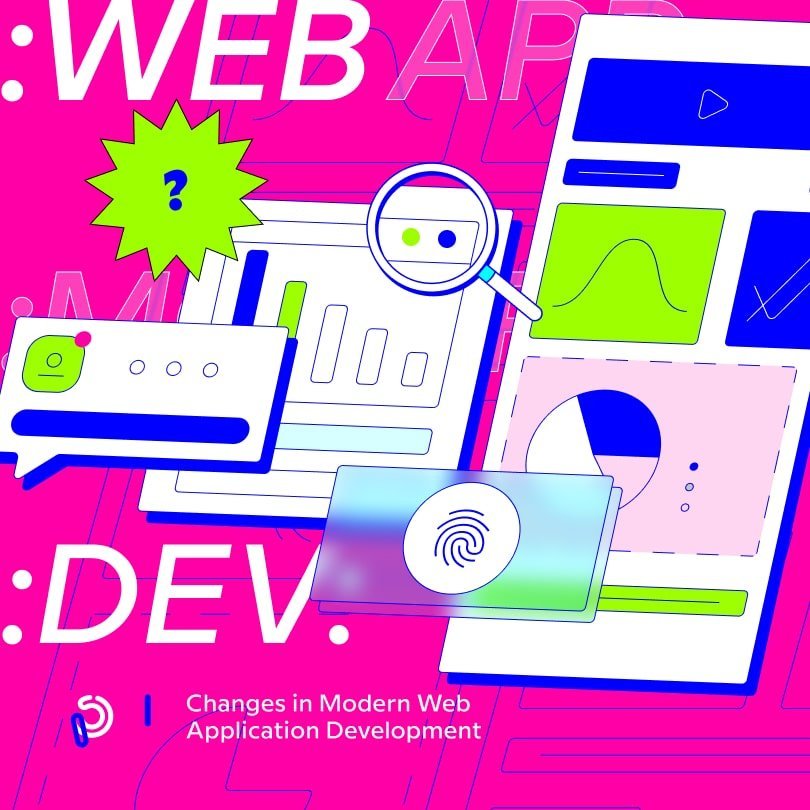Web application development is a rapidly transforming field encompassing top-notch technologies, processes, and tools. Nowadays, it’s a necessary asset for businesses striving to obtain a competitive edge and be among the market leaders.
Using web applications leads to sustainable growth and a higher bottom line due to improved accessibility and efficiency. However, it wasn’t always that way.
These tools have come a long way since their early days. Before, the performance was lagging, and users had to download mobile apps. But websites are now more responsive, and it’s possible to use web applications on various devices and screen sizes.
Moreover, the percentage of web applications containing high-risk vulnerabilities decreased by 17 percent in 2019. Numerous companies and e-commerce stores are enhancing their web development efforts and following the user-first approach.
Over 47 percent of people expect websites to load in two seconds or less, while 94 percent perceive mobile-friendliness as a deciding factor in whether they will continue scrolling. Apps can make or break your customer loyalty.
For instance, more than 40 percent of all users buy more of a brand’s products after downloading its e-commerce app. Thus, nearly 46 percent end up visiting their physical store more often.
Therefore, you should know the trends and changes impacting modern web application development if you want to provide a stellar user experience to your visitors. But let’s start with what makes web apps and websites different.
What are Web Applications?
Web applications stand for interactive apps developers create using web development tech, providing users with easy access directly from their browsers. The usual front-end and back-end technologies serve in building these apps, but they aren’t the same as websites.
5 Ways Modern Web Application Development is Changing
Artificial Intelligence (AI) and Chatbots
Chatbots are necessary for ensuring the customers have the essential information about products, services, and relevant policies without interacting with customer support and managers. However, they are going to become more helpful and kinder.
Because of that, up to 85 percent of customers won’t engage with humans in 2022. Instead, intelligent chatbots will help them find answers and solutions faster, ensuring a better experience.
Blockchain
The worth of the blockchain market could reach $67.4 billion by 2026. This technology improves security and streamlines transactions by removing intermediaries from the equation.
Many large companies, banks, e-commerce stores, and finance firms already use them to replace the centralized web app structure, but the number of businesses choosing this approach will increase in the years to come.
Motion User Interface (UI)
Web developers will experiment with Motion UI to increase web app simplicity, improve their web strategy, and highlight the areas visitors should see first. Tacky ads and GIFs are entering the outdated territory, and moderate and slick designs are gaining popularity.
However, the use of Motion UI in web app development it’s still in its early stages and requires skilled PHP developers who can create seamless motions. But this trend will likely grow in the future, bringing back decluttered aesthetics.
Virtual Reality (VR) and Augmented Reality (AR)
Many developers are already exploring the VR/AR world and leveraging its cutting-edge features. These interactive technologies make it easier to reach the target audience and provide an authentic experience.
Thus, social networks already leverage VR/AR tech to stay ahead of their competitors and drive innovation. Therefore, modern web app development could have various 3D features.
Moving Backgrounds and Videos
Nothing draws attention as much as captivating videos. It allows businesses and content creators to present themselves and their products more effectively and remarkably.
That boosts conversion and customer loyalty. As a result, moving backgrounds and engaging videos will likely be a must for high-performing modern web apps.
The Difference Between Web Apps and Mobile Websites
Unlike web apps, mobile websites aren’t interactive, and they solely present data and information. Hence, the former consists of optimization that makes it compatible with mobile devices and uses smaller fonts.
Mobile websites also have limited white space and fewer page grids and elements. Moreover, they are hosted under one domain name on a server.
On the other hand, web applications are software hosted on one or various servers, and users access them via the internet browser. Unlike websites, they are highly interactive, have more integration options, and typically require authentication.
That makes web apps more portable, convenient, and easier to develop. There are three types:
- Client-Side Web Apps – These apps are typical in front-end development and center around the user interface (UI).
- Server-Side Web Apps – Back-end development goes hand in hand with these apps, making them nearly synonymous. They are more secure and compatible with more browsers than client-side web apps.
- Single-Page Web Apps – Nowadays, most websites people use every day fall under this category. Facebook, Medium, GitHub, Gmail, and Google Maps are the best examples.

The Characteristics of Modern Web Application Development
Users have higher expectations from web apps today and want 24/7 access, regardless of their geographic location. But they also require the ability to use their apps on any device without the screen size affecting their user experience.
These demands led to a rise in modern web application development. The goal is to make these apps more scalable, secure, and adaptable.
Users-first is the guiding principle in developing modern web applications. Because of that, the loading time is faster than before, and people can access their apps without any hurdles.
Although that’s still a work in progress, developers strive to make security non-negotiable in modern web app development. They also must use more programming languages and tools to build efficient and fast apps.
But this field is continuously changing as new technologies arise and enable innovation to thrive. Here are the top five transformations in web app development.
Conclusion
Nothing remains same in modern web app development solutions for an extended period of time. It continuously transforms, bringing tools that make the user experience better.
Web apps underwent significant changes in the past few years, becoming more secure, fast, and streamlined. The emergence of new technologies and trends will undoubtedly continue revamping them.
That creates new opportunities for web developers to increase web app customization and provide more flexible solutions and better UX.





